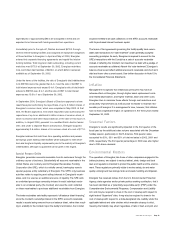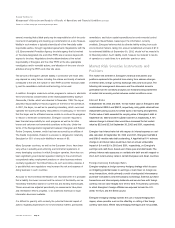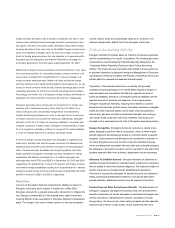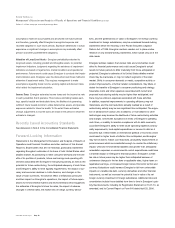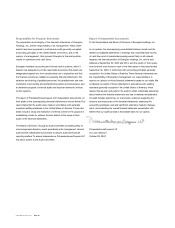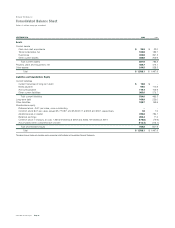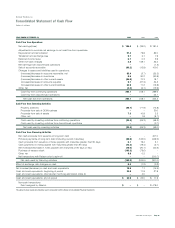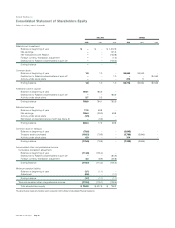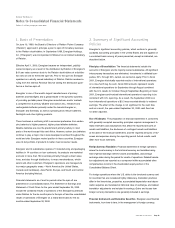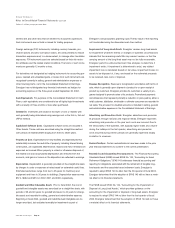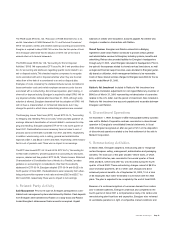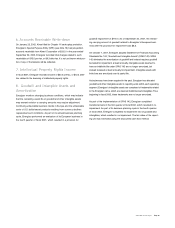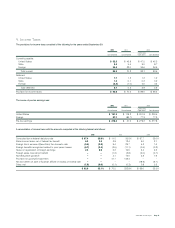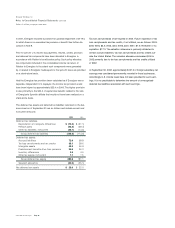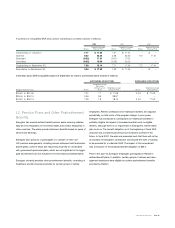Energizer 2002 Annual Report Download - page 27
Download and view the complete annual report
Please find page 27 of the 2002 Energizer annual report below. You can navigate through the pages in the report by either clicking on the pages listed below, or by using the keyword search tool below to find specific information within the annual report.
1. Basis of Presentation
On June 10, 1999, the Board of Directors of Ralston Purina Company
(“Ralston”) approved in principle a plan to spin off its battery business
to the Ralston stockholders. In September 1999, Energizer Holdings,
Inc. (“Energizer”) was incorporated in Missouri as an indirect subsidiary
of Ralston.
Effective April 1, 2000, Energizer became an independent, publicly
owned company as a result of the distribution by Ralston of Energizer’s
$.01 par value common stock to the Ralston stockholders at a distribu-
tion ratio of one for three (the spin-off). Prior to the spin-off, Energizer
operated as a wholly owned subsidiary of Ralston. Ralston received a
ruling from the Internal Revenue Service stating the distribution quali-
fied as a tax-free spin-off.
Energizer is one of the world’s largest manufacturers of primary
batteries and flashlights and a global leader in the dynamic business
of providing portable power. Energizer manufactures and/or markets
a complete line of primary alkaline and carbon zinc, miniature and
rechargeable batteries primarily under the brands Energizer e2,
Energizer and Eveready, as well as specialty photo lithium batteries,
flashlights and other lighting products.
There has been a continuing shift in consumer preference from carbon
zinc batteries to higher powered, higher priced alkaline batteries.
Alkaline batteries are now the predominant primary battery in most
parts of the world except Asia and Africa. However, carbon zinc batteries
continue to play a major role in less developed countries throughout the
world and offer Energizer market position in those countries. Energizer
uses its full portfolio of products to better meet consumer needs.
Energizer and its subsidiaries operate 21 manufacturing and packaging
facilities in 14 countries on four continents. Its products are marketed
and sold in more than 150 countries primarily through a direct sales
force, and also through distributors, to mass merchandisers, whole-
salers and other customers. Energizer’s operations are managed via
four major geographic areas – North America (the United States,
Canada and Caribbean), Asia Pacific, Europe, and South and Central
America (including Mexico).
Financial statements as of and for periods after the spin-off are
presented on a consolidated basis. The Statement of Earnings and
Statement of Cash Flows for the year ended September 30, 2000
include the combined results of operations of the Energizer businesses
under Ralston for the six months prior to the spin-off and the consolidated
results of operations of Energizer on a stand-alone basis for the six
months ended September 30, 2000.
2. Summary of Significant Accounting
Policies
Energizer’s significant accounting policies, which conform to generally
accepted accounting principles in the United States and are applied on
a consistent basis among all years presented, except as indicated, are
described below.
Principles of Consolidation The financial statements include the
accounts of Energizer and its majority-owned subsidiaries. All significant
intercompany transactions are eliminated. Investments in affiliated com-
panies, 20% through 50% owned, are carried at equity. Prior to fiscal
2001, Energizer historically reported results of international operations
on a one-month lag. As such, fiscal 2000 amounts represent results
of international operations for September through August combined
with the U.S. results for October through September. Beginning in fiscal
2001, Energizer synchronized international operations’ reporting to be
consistent with U.S. reporting. As a result, the September 2000 loss
from international operations of $3.3 was recorded directly to retained
earnings. The effect of the change is not significant to the cash flow,
and as a result, the year ended September 30, 2000 cash flow has
not been adjusted.
Use of Estimates The preparation of financial statements in conformity
with generally accepted accounting principles requires management to
make estimates and assumptions that affect the reported amounts of
assets and liabilities, the disclosure of contingent assets and liabilities
at the date of the financial statements, and the reported amounts of rev-
enues and expenses during the reporting period. Actual results could
differ from those estimates.
Foreign Currency Translation Financial statements of foreign operations
where the local currency is the functional currency are translated using
end-of-period exchange rates for assets and liabilities, and average
exchange rates during the period for results of operations. Related transla-
tion adjustments are reported as a component within accumulated other
comprehensive income in the shareholders equity section of the
Consolidated Balance Sheet.
For foreign operations where the U.S. dollar is the functional currency and
for countries that are considered highly inflationary, translation practices
differ in that inventories, properties, accumulated depreciation and depre-
ciation expense are translated at historical rates of exchange, and related
translation adjustments are included in earnings. Gains and losses from
foreign currency transactions are generally included in earnings.
Financial Instruments and Derivative Securities Energizer uses financial
instruments, from time to time, in the management of foreign currency,
Energizer Holdings, Inc.
Notes to Consolidated Financial Statements
(Dollars in millions, except per share data)
ENR 2002 Annual Report Page 25


